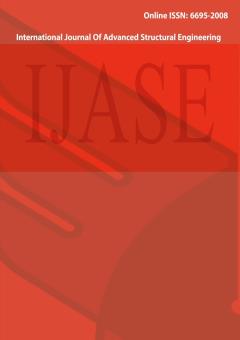Experimental Investigation on the Mechanical Properties of Goat Hair Fiber Reinforced Concrete
Subject Areas : Innovative Construction Materials
somayeh hatami
1
![]() ,
Eslam Rezaei
2
,
Eslam Rezaei
2
1 -
2 -
Keywords: Goat hair, Fiber reinforced concrete, Compressive strength, Tensile strength, Workability,
Abstract :
One of the disadvantages of concrete is low tensile strength and poor crack resistance. The use of fibers in the concrete mixing design is an effective and practical method to increase ductility and energy absorption capacity, reduce cracking and enhance the tensile strength of concrete. Using natural fibers in concrete is always recommended with the aim of saving non-renewable resources and using sustainable materials. In this research, the effect of using goat hair as an example of natural fibers on the mechanical properties of concrete was investigated. To achieve this goal, concrete samples were made with different percentages of 0, 0.25, 0.5, 0.75 and 1% goat hair with a length of 13-22cm and diameter of 50-60 microns. To assess the effectiveness of this fiber, plain concrete properties were used. The results indicated that the addition of goat hair fibers increases the compressive and tensile strength of concrete samples at ages 7 and 28-day. This fact was more evident in the samples containing 0.5% goat hair with respect to the weight of cement. For example, at the age of 28-day the improvements in compressive and tensile strength was 18.2% and 83.4%, respectively. Also, by adding goat hair fibers to concrete, workability was reduced and concrete samples containing 0.75% or less fibers had acceptable workability. In general, the use of 0.5% of goat hair fibers is recommended as the optimal percentage in reinforced concrete due to its effect on the mechanical properties of concrete and economic efficiency.
[1] Reis, J. M. L. (2006). Fracture and flexural characterization of natural fiber-reinforced polymer concrete. Construction and building materials. 20(9), 673-678. https://doi.org/10.1016/j.conbuildmat.2005.02.008
[2] Shah, I., Li, J., Yang, S., Zhang, Y., & Anwar, A. (2022). Experimental investigation on the mechanical properties of natural fiber reinforced concrete. Journal of Renewable Materials. 10(5), 1307-1320. https://doi.org/10.32604/jrm.2022.017513
[3] Balasubramanian, J. C., & Selvan, S. S. (2015). Experimental investigation of natural fiber reinforced concrete in construction industry. International Research Journal of Engineering and Technology. 2(1), 179-182.
[4] Geremew, A., De Winne, P., Demissie, T. A., & De Backer, H. (2021). Treatment of natural fiber for application in concrete pavement. Advances in Civil Engineering. 2021, 1-13.
https://doi.org/10.1155/2021/6667965
[5] Krishna, N. K., Prasanth, M., Gowtham, R., Karthic, S., & Mini, K. M. (2018). Enhancement of properties of concrete using natural fibers. Materials Today: Proceedings. 5(11), 23816-23823.
https://doi.org/10.1016/j.matpr.2018.10.173
[6] Mansilla, C., Pradena, M., Fuentealba, C., & César, A. (2020). Evaluation of mechanical properties of concrete reinforced with eucalyptus globulus bark fibres. Sustainability. 12(23), 10026.
https://doi.org/10.3390/su122310026
[7] Poorsaheli, H. B., Behravan, A , & Aghda, S. T. T. (2021). Durability performance of hybrid reinforced concretes (steel fiber+ polyolefin fiber) in a harsh marine tidal zone of Persian Gulf. Construction and Building Materials. 266, 121176.
https://doi.org/10.1016/j.conbuildmat.2020.121176
[8] Qiao, X., Ni, S., Lu, H., Wang, X., & Zhou, X. (2021). A novel method to prepare chemical fibers by plasticizing cotton with 1-allyl-3-methylimidazolium chloride. International Journal of Biological Macromolecules. 166, 1508-1512.
https://doi.org/10.1016/j.ijbiomac.2020.11.030
[9] Rostami, R., Zarrebini, M., Mandegari, M., Sanginabadi, K., Mostofinejad, D., & Abtahi, S. M. (2019). The effect of concrete alkalinity on behavior of reinforcing polyester and polypropylene fibers with similar properties. Cement and Concrete Composites. 97, 118-124.
https://doi.org/10.1016/j.cemconcomp.2018.12.012
[10] Rucka, M., Wojtczak, E., Knak, M., & Kurpińska, M. (2021). Characterization of fracture process in polyolefin fibre-reinforced concrete using ultrasonic waves and digital image correlation. Construction and Building Materials. 280, 122522.
https://doi.org/10.1016/j.conbuildmat.2021.122522
[11] Banthia, N. (2010). Report on the physical properties and durability of fiber-reinforced concrete. American Concrete Institute, U.S.
[12] Naaman, A. E. (1985). Fiber reinforcement for concrete. Concrete International. 7(3), 21-25.
[13] Porter. H. F. (1910). Preparation of Concrete from selection of materials to final disposition. Proceedings of the National Association of Cement Users. ACJ, Vol 6.
[14] Fickley, W. (1914). Improvements in reinforcing structures and wearing surfaces of hydraulic, bituminous like cement, concrete, asphalt. British Patent N°11754: May 1914.
[15] Shi, C., & Mo Y. L. (2008). High-performance construction materials: science and applications. World scientific, Singapore.
[16] Singh, S. P., Singh, A. P., Bajaj, & V. (2010). Strength and flexural toughness of concrete reinforced with steel – polypropylene hybrid fibers. Asian Journal of Civil Engineering (Building and Housing). 11 (4): 494–507.
[17] Ali, M., Liu, A., Sou, H., & Chouw, N. (2012). Mechanical and dynamic properties of coconut fibre reinforced concrete. Construction and Building Materials. 30: 814-25.
https://doi.org/10.1016/j.conbuildmat.2011.12.068
[18] Kumar, A. (2014). A study on mechanical behaviour of hair fiber reinforced epoxy composites. Dissertation, National Institute of Technology, Rourkela
[19] Razavi, V., (2018). Different Percentage of Bagass and Hair of Goat in Concrete Slab: Application, PSC Reduction, and Strength. Soil Structure Interaction Journal. 1(1), 47-52.
[20] ASTM Standard C33/C33M-18 (2018). Specification for concrete aggregates. American Society for Testing and Materials.
[21] ASTM Standard C1602/C1602M-18 (2018). Standard specification for mixing water used in the production of hydraulic cement concrete. American Society for Testing and Materials.
[22] ASTM Standard C150/C150M-18 (2018). Standard specification for Portland cement. American Society for Testing and Materials.
[23] ACI Committee 544 (2018). Guide to design with fiber-reinforced concrete. American Concrete Institute.
[24] ASTM Standard C143/C143M (2018). Standard test method for slump of hydraulic-cement concrete. American Society for Testing and Materials.
[25] ASTM Standard C39/C39M-18 (2018). Standard test method for compressive strength of cylindrical concrete specimens. American Society for Testing and Materials.
[26] ASTM Standard C496/C496M-18 (2018). Standard test method for splitting tensile strength of cylindrical concrete specimens. American Society for Testing and Materials.


